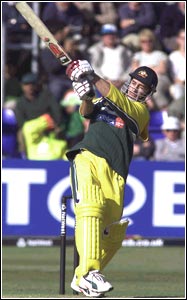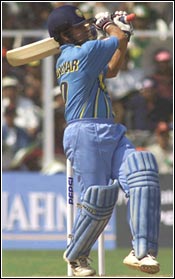What lies beneath... the averages
Subodh S. Chitre
As the One-Day International matures as a form of the game, the yardsticks for measuring performance are getting clearer.
For example, in Test cricket in the last 30 years or so, most top-class batsmen have had batting averages of between 50 and 60. With that knowledge, one can evaluate how good a particular batsman is with respect to these champions. The ODI format required some time to mature, such that there was enough data to come to a reasonable conclusion. Now, one can say, that the yardstick for greatness can be developed for ODIs too.
 Here most good batsmen average between 40 and 50. These include the likes of Vivian Richards, Sachin Tendulkar, Sourav Ganguly, Saeed Anwar and Mark Waugh to name a few. One batsman, however, stands tall in this battle of averages: Michael Bevan. He has an average of more than 57 runs per innings. To put things in perspective, his average indicates that he scores about 35 per cent more runs per innings than Tendulkar.
Here most good batsmen average between 40 and 50. These include the likes of Vivian Richards, Sachin Tendulkar, Sourav Ganguly, Saeed Anwar and Mark Waugh to name a few. One batsman, however, stands tall in this battle of averages: Michael Bevan. He has an average of more than 57 runs per innings. To put things in perspective, his average indicates that he scores about 35 per cent more runs per innings than Tendulkar.
It is intriguing to think that there exists a batsman with a batting average so significantly above that of a batsman regarded by most as the best in the world. Fuelled by both curiosity and chauvinism, I proceeded to delve deeper into a comparison of Tendulkar and Bevan. The results indicate a far different viewpoint than what the averages simplistically indicate.
Most observers of world cricket are aware that Bevan has several 'not-out' innings to his name. Therefore, my fundamental hypothesis was that his average has been inflated due to the number of innings in which he has remained not out (which don't get counted in the average calculation). The facts are as follows:
a) Tendulkar has remained not out on 25 occasions out of 266 innings - about 9 per cent;
b) Bevan has remained not out on 51 occasions out of 154 innings - about 35 per cent;
This has a great impact on the average calculation. The primary feeling is: disregard the not-outs and compare averages of the two players in the innings they have been dismissed. On doing that, Bevan's average dismissal came after his scoring 34 runs, while for Tendulkar that number was 36. One would hastily end the argument here by showing that Tendulkar indeed has a better average, when one doesn't resort to arithmetic adjustments.
One could, but it's unfair to neglect 35 per cent of Bevan's career altogether. Maybe, he is a batsman who simply doesn't get out when he plays well, so all his not-out innings could be high scoring ones.
A good way around it is to compare the 'distribution' of runs made by these two batsmen in different bands. The results are as follows:
| Runs |
Tendulkar % of innings |
Bevan % of innings |
| 0-20 |
39.8 |
29.7 |
| 20-40 |
22.9 |
31.0 |
| 40-60 |
11.3 |
21.4 |
| 60-80 |
8.6 |
11.7 |
| 80-plus |
17.3 |
6.2 |
|
This distribution gives a far clearer picture of their batting patterns than a simple arithmetic average.
Tendulkar is far more prone to getting out early than Bevan is. Bevan, on the other hand, often tends to finish his innings with a moderate score (20-60). But for much higher scores, Tendulkar clearly outclasses Bevan. This pattern is perhaps due to the position that the two batsmen bat at. Since Tendulkar comes in early, he has to face the new ball and also try to take advantage of the fielding restrictions in the first 15 overs. Bevan comes with an altogether different agenda: scout for ones and twos till the innings is over, but he does not get as much of a chance to build a long innings.
Considering that a batting score of 40 is recognized as a solid ODI contribution, what is the likelihood of each of them doing so?
Well, for Tendulkar it is 37 per cent while for Bevan it is 39 per cent In fact, if you consider Tendulkar's scores after 1995, this likelihood for him increases to about 42 per cent. Not a very significant difference indeed, either way. One can safely say, therefore, that both batsmen have shown thus far an almost equal propensity to make a significant contribution.
Next in line is the issue of whether these contributions are worthwhile. Tendulkar has scored more than 40 runs on 99 occasions. 62 of them resulted in a victory for India - about 63 per cent. For Bevan, 37 out of his 57 scores of above 40 yielded an Australian victory - about 65 per cent.
 Therefore, their ability to contribute to their team victory has thus far been almost equal. As an aside, on 65 per cent of the occasions that Tendulkar has scored few runs (< 20), India has lost the match. For Bevan, it's been only 41 per cent of the times. But that has a lot to do with the abilities of the rest of the rest of the team too.
Therefore, their ability to contribute to their team victory has thus far been almost equal. As an aside, on 65 per cent of the occasions that Tendulkar has scored few runs (< 20), India has lost the match. For Bevan, it's been only 41 per cent of the times. But that has a lot to do with the abilities of the rest of the rest of the team too.
So, all in all, through a simple analysis it is clear that based on what they have done, there is little to choose between the two batsmen. But that is still only a part of the story.
We started this analysis with the hypothesis that Bevan's average is inflated by his not-out innings. Now, why does one not count the not-out innings? Because it's technically unknown as to how much that batsman could have scored in that particular innings. So now, based on how much each of these batsmen could have scored, how do they compare?
That's a tricky question, and no matter what method one employs, there would be inadequacies. Well, the proposed solution attempts to find a corrected average for the two players. To do so, we use the following method:
a) Segregate the dismissals from the non-dismissals. As mentioned earlier, Tendulkar has been dismissed at 36 runs per innings, while Bevan at 34.
b) For the non-dismissals, segregate them further into those under the dismissal average and those above it. For example, for all the 25 innings that Tendulkar has remained not out, find the number of times he has done so with a score below 36 and with one above 36. For Bevan, it's below and above 34.
c) For all non-dismissals below the dismissal average, assume that the batsman would have been dismissed for his dismissal average. (There is no evidence to suggest that it would not have been a typical dismissal). Therefore, for example, Tendulkar has remained not out below 36 on 7 occasions. For each of those 7 innings we record his score as 36.
d) For non-dismissals above the dismissal average, it gets difficult to formulate a policy. Here the batsman has gone beyond his dismissal average and hence it is difficult to pin his probable score to an upper bound. For lack of an objective basis, we choose the batsman's highest score. The logic is that each of those innings is an above-average inning and thus the batsman can technically score as much as he has ever scored (of course, he can score even better, but we would then get into the realm of the infinite, with little use).
Therefore, for example, Bevan has been not out above 34 on 31 occasions. We record a score of 107 (his highest) for each of these innings. This is clearly favouring Bevan since he has many more not-outs above his dismissal average than Tendulkar does. Tendulkar (or more likely his analytical fans) might point out that Tendulkar's highest score is itself a non-dismissal (186 not out) hence one can't use that upper bound. Well, that's true but there isn't a way out of that one.
So what is the result of this bizarre adjustment? Well, Bevan's corrected average works out to about 50, while Tendulkar's corrected average is about 46. Again, not a significant difference considering that the method has limitations and it also intrinsically favours Bevan.
What is emerging is an important realization that we need to internalize. Bevan is definitely not "head and shoulders" above the rest of the world. It appears so only due to arithmetic adjustments of not accounting for his not-out innings. His comparison to Tendulkar indicates that they are both in the same domain of greatness with very little to choose. They show similar propensity to contribute significantly. The effect of these contributions on their team's fortunes is also similar.
Yes, Bevan has contributed many more times with an unbeaten knock in a successful Australian run-chase. He has done so in about 15 per cent of his innings, while Tendulkar has managed to do so only in 7 per cent of his attempts. So, if one were to allow some degree of impishness, one can say that while Tendulkar is the better opening batsman, Bevan is the better closing batsman.
Editor's note: Rediff believes that like its own editorial staffers, readers too have points of view on the many issues relating to cricket as it is played.
Therefore, Rediff provides in its editorial section space for readers to write in, with their views. The views expressed by the readers are carried as written, in order to preserve the original voice.
However, it needs mentioning that guest columns are opinion pieces, and reflect only the feelings of the individual concerned -- the fact that they are published on Rediff's cricket site does not amount to an endorsement by the editorial staff of the opinions expressed in these columns.
Mail Subodh S. Chitre